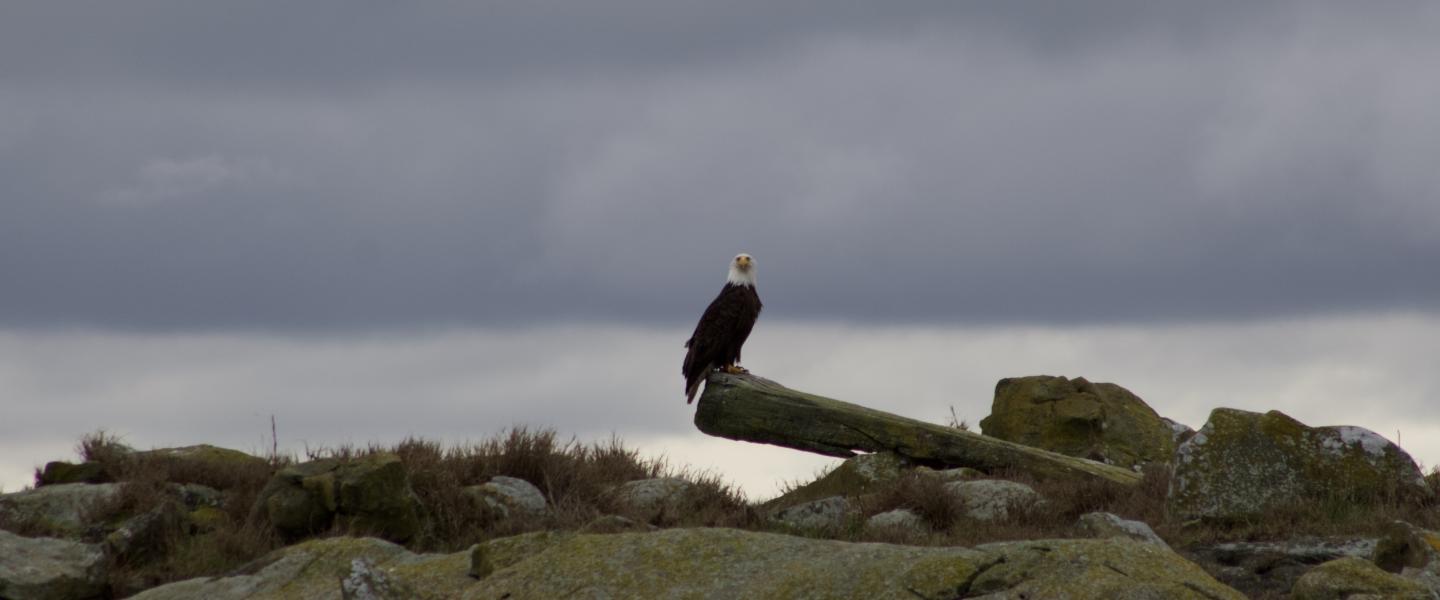
[Friday, 3/2/18 - 12:00 - M/V Sea Lion - Naturalist Erick]
A Steller Start
Here at San Juan Safaris we are having a great time since starting one-a-day tours on March 1st. This Friday, Captain Mike and I took out a small group of folks to look for wildlife on a quintessential Pacific Northwest weather day. There was no rain but all around you could see the tree tops scraping the clouds and creating the undulating mist that often surrounds the islands this time of year. Mike and I first traveled north in San Juan Channel past Yellow and Jones Islands until we reached Spieden Island just north of San Juan. On the eastern tip of Spieden there is a sloping, rocky point and on it were literal tons of Steller Sea Lions. This group of Stellers were mostly adult males and you could tell both from their enormous size and their pronounced sagittal crests (the big, manly bumps on their foreheads). These giants are one of my favorite animals in the Salish Sea and we are always lucky when we see them since they only spend their winters among the islands and this eastern Pacific population is still classified as Near Threatened despite being protected for a few decades now. After watching a few of the males growl and brawl over their favorite piece of rock we headed just a little bit further north to the Cactus Islands.
A Funny name, I know
A funny name, I know, for a few fir-covered temperate islands in the rainy PNW, but the San Juan Islands as well as a few other places in southern British Columbia and western Washington state sit in a sizeable rain shadow created by the Olympic Mountain range and the tall peaks of Vancouver Island. This rain shadow – often referred to as the ‘banana belt’ due to its shape on a map not for the banana plants that no one can grow here – creates a semi-arid environment and in San Juan County we get around half as much rain as Seattle does. Thus, the Cactus Islands named after a native Opuntia species that inhabits this region.
Blubbery Mermaids
Just in between the Cactus Islands is a very current rich and rocky area. There are many rocks that just poke out of the water and our furry, pinniped friends, the Harbor Seals, love to rest their weary, blubbery selves there. There was around twenty of these close relatives to the Sea Lions that we had just seen doing the mermaid pose on half-submerged rocks and even a few swimming around the swirling waters. These little grey and tan nuggets are probably the most recognizable characters in our waters and since they call this area home year-round, they are kind of a de facto mascot. They are so cute and also fascinating. They are incredible marine hunters since they can track and catch fish without the use of their eyes or ears (scientist blindfolded and ear-muffed a few to test this) and also stay under water over 30 minutes after emptying their lungs. What amazing creatures!
Next, we cruised around a bit searching for even more inspiring wildlife. We crossed Boundary Pass and spied a small group of adult and juvenile Bald Eagles perched on Java Rocks. Even though we love to imagine Bald Eagles as strong, majestic, soaring birds-of-prey they spend most of their time sitting still and just waiting for other animals – like cormorants or seals – to catch a fish that they can then steal. Oh, and they are more than a little goofy.
A Pod of not so on Porpoises!
We crossed back over Boundary pass and looked around Skipjack Island – one of the many wildlife refuges in the islands – to see what was around. One of our guests spotted a few fins in the distance and when we went over to check them out we found that it was a large group of Harbor Porpoises! They were swimming and hunting in the large tidal rip current that had developed on the south side of Skipjack Island! It had a been a while since I had seen so many in one place. We shut the engine off and sat and listened to their splashing and breathing in the dim, misty light of the afternoon. These porpoises are the second smallest cetacean (whale) species in the world and I always love when we see them. From a distance they do look like dolphins and porpoises as a whole group are closely related to dolphins, but porpoises are definitely the older group evolutionarily and the main physical differences that one can look for are that porpoises have flat, spatula-shaped teeth, flattened faces, and triangular shaped dorsal fins. Dolphins, in contrast, have cone-shaped teeth, elongated faces, and sickle-shaped or wave-shaped dorsal fins. Now…you…know! After we hung out with this pod for a while it was unfortunately time to head back home. What another amazing day full of wildlife! I wonder what we will find the next time we go out!
Erick
Erick Dowell